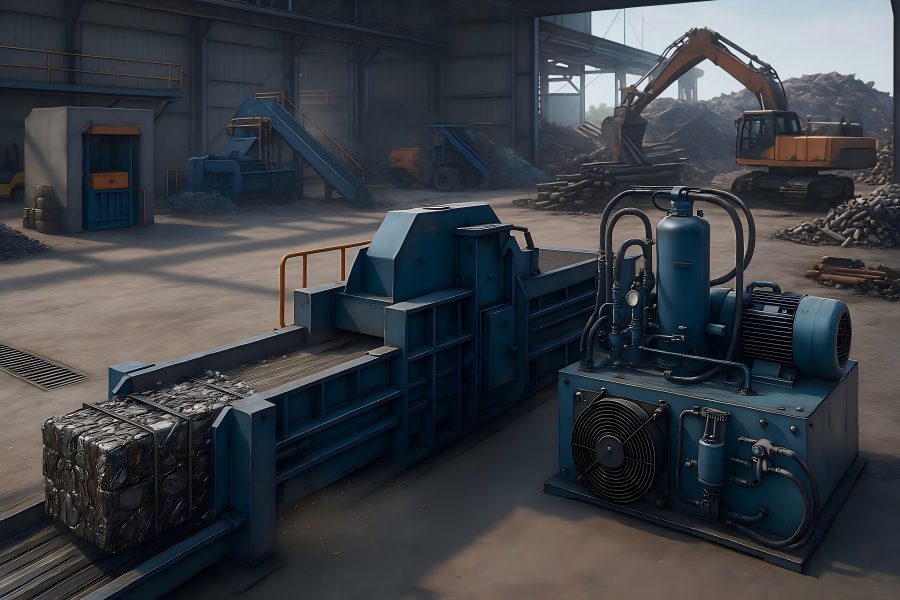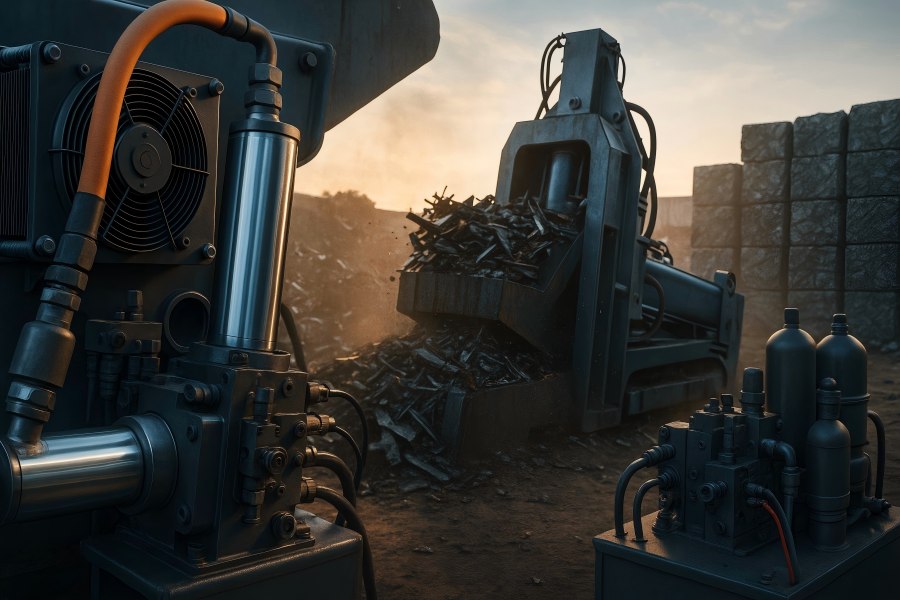Hydraulic gantry shear machines are essential in metalworking, offering powerful solutions for cutting, shearing, and compacting metals in scrap yards, construction, and manufacturing. They efficiently handle large material volumes, making them crucial for high-throughput operations.
Chamber size is critical to hydraulic gantry shear efficiency, influencing both throughput and shear quality. This article examines its effect on performance and offers guidance on choosing the right chamber size for various industrial applications.
Understanding Hydraulic Gantry Shear Machines
Hydraulic gantry shear machines are designed to shear or cut through various types of metal, from steel beams to aluminum sheets, by applying significant force through a hydraulic mechanism. The hydraulic system ensures that the machine has the necessary power to process metal with precision and consistency.
These machines perform several key functions:
- Cutting: The primary function is to cut metal materials into desired shapes and sizes.
- Shearing: Hydraulic gantry shears apply force to shear metal, which is especially useful in recycling operations where metal needs to be broken down into smaller parts for further processing.
- Compacting: In some operations, the machines also compact the metal, reducing its volume for easier transport and recycling.
Typical applications of hydraulic gantry shears include:
- Metal Recycling: Breaking down scrap metal into manageable pieces for reprocessing.
- Construction: Cutting metal beams and sheets for use in building infrastructure.
- Manufacturing: Precision cutting of metal components for machinery, automotive parts, and other products.
The Role of Shear Chamber Size
The shear chamber size refers to the volume or space where the metal is placed before it is cut. It defines the capacity of the machine to hold and process materials.
- Chamber Size and Material Handling: A larger chamber allows the machine to accommodate bigger or larger quantities of metal at a time. This means that more material can be sheared or cut in a single pass, increasing operational efficiency. Conversely, smaller chambers are designed for more precise operations where cutting smaller metal pieces or handling fine-tuned applications is necessary.
- Correlation Between Chamber Size and Machine Efficiency: The size of the chamber plays a critical role in the efficiency of hydraulic gantry shears. Larger chambers typically result in faster throughput, meaning more metal can be processed within a given time. However, there are trade-offs: larger chambers might compromise precision and cutting quality, particularly in more delicate operations. Smaller chambers offer enhanced precision, especially in industries where clean and accurate cuts are critical.
How Chamber Size Affects Throughput and Shear Quality
Throughput in hydraulic gantry shear machines is greatly influenced by chamber size, which determines how much material can be processed per cycle. By categorizing chamber sizes into large, medium, and small, we can better understand the trade-offs between throughput and shear quality in different metalworking operations.
Comparison Table of Different Chamber Sizes
| Chamber Size (m³) | Material Capacity (Tons) | Throughput (Tons per Hour) | Precision Level | Best Application |
| Large (4-5 m³) | 4-5 tons | 2-3 tons/hour | Low (±0.3 mm) | High-volume recycling, large-scale metal cutting |
| Medium (2-3 m³) | 2-3 tons | 1-1.5 tons/hour | Moderate (±0.2 mm) | Mid-sized recycling, construction |
| Small (0.5-1 m³) | 0.5-1 ton | 0.2-0.5 tons/hour | High (±0.1 mm) | Precision manufacturing, small-scale metalworking |
Large Chamber Sizes
Large chamber sizes, typically ranging from 4 m³ to 5 m³, are designed for high-throughput applications where processing large volumes of metal quickly is the main priority. These chambers accommodate bulky and heavy materials such as scrap metal, large beams, or pipes. The primary benefit of a large chamber size is that it allows a significant amount of material to be processed in a single cycle, reducing downtime and increasing overall productivity.
- Throughput Advantage: A large chamber of 5 m³, for example, can process up to 5 tons of metal per cycle, with a throughput rate of 3 tons per hour. This makes it ideal for industries such as scrap metal recycling or large-scale construction, where speed and volume are critical.
- Material Handling: Larger chambers can handle heavy-duty materials that may not fit into smaller chambers. For example, a 5 m³ chamber can process large steel beams in one go, reducing the number of cycles required and thus maximizing throughput.
However, while large chambers excel in high-throughput environments, they often sacrifice shear quality. Larger chambers are designed to handle bulk materials and prioritize speed over precision. As a result, the cuts produced in large chambers may be less precise, with rougher edges. This is suitable for industries such as metal recycling, where the priority is on efficiently handling large quantities of material.
Medium Chamber Sizes
Medium-sized chambers, generally ranging from 2 m³ to 3 m³, offer a balance between throughput and precision. These chambers are suitable for operations that require moderate processing speed and capacity but still need some level of precision. Medium chambers are often used in mid-sized recycling facilities or in manufacturing environments where a combination of volume and quality is necessary.
- Throughput Performance: A 3 m³ chamber, for example, can process up to 1.5 tons of material per cycle, with a throughput rate of 1.5 tons per hour. This throughput level is ideal for mid-sized recycling plants or construction sites that process moderately sized metal components.
- Material Handling: Medium chambers can process a wide range of materials, from smaller metal sheets to mid-sized scrap components. They offer a good balance between handling bulk materials and maintaining sufficient precision for certain applications.
Medium chambers strike a balance between throughput and shear quality. While they can process a considerable volume of material, they still maintain a relatively high level of control over the shearing process. This results in cleaner cuts compared to large chambers, although not as precise as smaller chambers.
Small Chamber Sizes
Small chamber sizes, typically ranging from 0.5 m³ to 1 m³, are designed for precision shearing rather than high-volume processing.These chambers are ideal for industries that demand precision, such as automotive manufacturing or metal fabrication. Although small chambers limit the amount of material processed per cycle, they offer greater control over the cutting process, ensuring higher-quality shears.
- Throughput Trade-offs: A small 1 m³ chamber may have a throughput rate of 0.5 tons per hour, which is significantly lower than that of larger chambers. However, the precision level achieved in each cycle can be extremely high, with tolerances as tight as ±0.1 mm. This makes small chambers suitable for industries where accuracy is prioritized over sheer volume.
- Material Handling: Small chambers are optimized for processing smaller, more delicate materials such as thin metal sheets or small components. They allow for precise positioning of the material within the chamber, resulting in cleaner cuts and minimized material waste.
Smaller chambers are ideal for industries that prioritize cut precision and quality. With smaller chambers, hydraulic gantry shears have more control over the shearing process, resulting in cleaner and more accurate cuts. This level of precision is crucial in manufacturing environments where components must meet tight tolerances, such as automotive or aerospace parts.

Choosing the Right Chamber Size for Your Operation
Selecting the appropriate chamber size depends on several factors:
Type of Material
The thickness, hardness, and composition of the metal being processed will influence the choice of chamber size. Thicker, bulkier materials (e.g., steel, iron) are better suited to larger chambers, while thinner, more delicate materials (e.g., aluminum, copper) require smaller chambers for precise shearing.
Desired Throughput
Industries that prioritize high throughput, such as recycling plants, should opt for larger chamber sizes to process more material per cycle. On the other hand, industries like automotive manufacturing, where precision matters more than speed, should select smaller chambers.
Desired Shear Quality
If the primary concern is the quality and precision of the cut, smaller chambers are ideal, as they offer better control over the material and result in cleaner shears. Larger chambers, while sacrificing some precision, offer faster processing for bulk materials.
Energy Efficiency
Larger chambers require more hydraulic power to process the material, leading to higher energy consumption. Smaller chambers typically consume less energy, helping to lower operational costs for companies prioritizing sustainability.
Space Constraints and Machine Footprint
The physical space available in your facility can also influence the chamber size you choose. Hydraulic gantry shears with larger chambers take up more space and require robust infrastructure. Smaller chambers are more compact, making them suitable for tighter workspaces.
Cost Considerations
The cost of the hydraulic gantry shear machine, including installation, maintenance, and energy consumption, must align with your operational budget. Larger machines are generally more expensive upfront but may offer long-term savings due to increased throughput.
Conclusion
Choosing the right chamber size for your hydraulic gantry shear machine is crucial for optimizing efficiency, precision, and productivity. By considering factors like material type, throughput, shear quality, energy efficiency, space, and cost, businesses can make informed decisions to enhance performance, whether focusing on high throughput or precision shearing.




